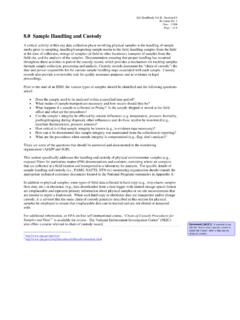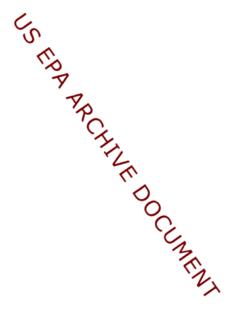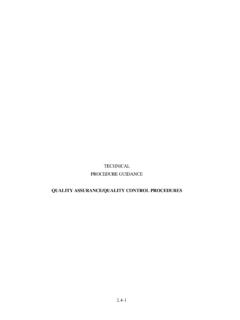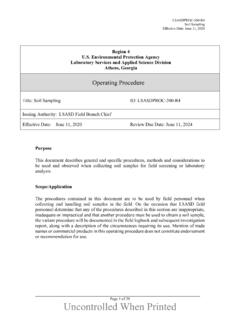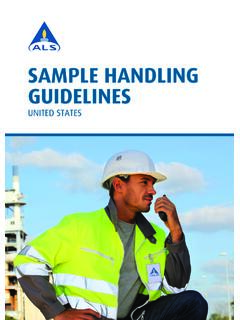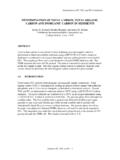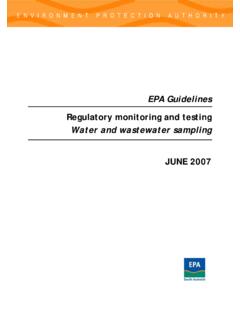Transcription of 17.0 Data Review, Verification and Validation
1 QA Handbook Vol II, Section Revision No: 1 Date: 12/08 Page 1 of 7 data Review, Verification and Validation data review, Verification and Validation are techniques used to accept, reject or qualify data in an objective and consistent manner. Verification can be defined as confirmation, through provision of objective evidence that specified requirements have been fulfilled1. Validation can be defined as confirmation through provision of objective evidence that the particular requirements for a specific intended use are fulfilled. It is important to describe the criteria for deciding the degree to which each data item has met its quality specifications as described in an organization s QAPP. This section will describe the techniques used to make these assessments. In general, these assessment activities are performed by persons implementing the environmental data operations as well as by personnel independent of the operation, such as the organization s QA personnel and at some specified frequency.
2 The procedures, personnel and frequency of the assessments should be included in an organization s QAPP. These activities should occur prior to submitting data to AQS and prior to final data quality assessments that will be discussed in Section 18. Each of the following areas of discussion should be considered during the data review/ Verification / Validation processes. Some of the discussion applies to situations in which a sample is separated from its native environment and transported to a laboratory for analysis and data generation; others are applicable to automated instruments. The following information is an excerpt from EPA G-52: Sampling Design - How closely a measurement represents the actual environment at a given time and location is a complex issue that is considered during development of the sampling design. Each sample should be checked for conformity to the specifications, including type and location (spatial and temporal).
3 By noting the deviations in sufficient detail, subsequent data users will be able to determine the data s usability under scenarios different from those included in project planning. Sample Collection Procedures- Details of how a sample is separated from its native time/space location are important for properly interpreting the measurement results. Sampling methods and field SOPs provide these details, which include sampling and ancillary equipment and procedures (including equipment decontamination). Acceptable departures (for example, alternate equipment) from the QAPP, and the action to be taken if the requirements cannot be satisfied, should be specified for each critical aspect. Validation activities should note potentially unacceptable departures from the QAPP. Comments from field surveillance on deviations from written sampling plans also should be noted. Sample Handling- Details of how a sample is physically treated and handled during relocation from its original site to the actual measurement site are extremely important.
4 Correct interpretation of the subsequent measurement results requires that deviations from the sample handling section of the QAPP and the actions taken to minimize or control the changes, be detailed. data collection activities should indicate events that occur during sample handling that may affect the integrity of the samples. At a minimum, investigators should evaluate the sample containers and the preservation methods used and ensure that they are appropriate to the nature of the sample and the type of data generated from the sample. Checks on the identity of the sample ( , proper labeling and chain of custody records) as well as proper physical/chemical storage conditions ( , chain of custody and storage records) should be made to ensure that the sample continues to be representative of its native environment as it moves through the analytical process. 1 ISO-9000 2 EPA Guidance to Quality Assurance Project Plans QA Handbook Vol II, Section Revision No: 1 Date: 12/08 Page 2 of 7 Analytical Procedures- Each sample should be verified to ensure that the procedures used to generate the data were implemented as specified.
5 Acceptance criteria should be developed for important components of the procedures, along with suitable codes for characterizing each sample's deviation from the procedure. data Validation activities should determine how seriously a sample deviated beyond the acceptable limit so that the potential effects of the deviation can be evaluated during DQA. Quality Control- The quality control section of the QAPP specifies the QC checks that are to be performed during sample collection, handling and analysis. These include analyses of check standards, blanks and replicates, which provide indications of the quality of data being produced by specified components of the measurement process. For each specified QC check, the procedure, acceptance criteria, and corrective action (and changes) should be specified. data Validation should document the corrective actions that were taken, which samples were affected, and the potential effect of the actions on the validity of the data .
6 Calibration- Calibration of instruments and equipment and the information that should be presented to ensure that the calibrations: were performed within an acceptable time prior to generation of measurement data were performed in the proper sequence included the proper number of calibration points were performed using standards that bracketed the range of reported measurement results otherwise, results falling outside the calibration range should be flagged as such had acceptable linearity checks and other checks to ensure that the measurement system was stable when the calibration was performed When calibration problems are identified, any data produced between the suspect calibration event and any subsequent recalibration should be flagged to alert data users. data Reduction and Processing- Checks on data integrity evaluate the accuracy of raw data and include the comparison of important events and the duplicate keying of data to identify data entry errors.
7 data reduction may be an irreversible process that involves a loss of detail in the data and may involve averaging across time (for example, 5-minute, hourly or daily averages) or space (for example, compositing results from samples thought to be physically equivalent) such as the Pb sample aggregation or spatial averaging techniques. Since this summarizing process produces few values to represent a group of many data points, its validity should be well-documented in the QAPP. Potential data anomalies can be investigated by simple statistical analyses. The information generation step involves the synthesis of the results of previous operations and the construction of tables and charts suitable for use in reports. How information generation is checked, the requirements for the outcome, and how deviations from the requirements will be treated, should be addressed. QA Handbook Vol II, Section Revision No: 1 Date: 12/08 Page 3 of 7 data Review Methods The flow of data from the field environmental data operations to the storage in the database requires several distinct and separate steps: initial selection of hardware and software for the acquisition, storage, retrieval and transmittal of data organization and the control of the data flow from the field sites and the analytical laboratory input and Validation of the data manipulation, analysis and archival of the data submittal of the data into the EPA s AQS database.
8 Both manual and computer-oriented systems require individual reviews of all data tabulations. As an individual scans tabulations, there is no way to determine that all values are valid. The purpose of manual inspection is to spot unusually high (or low) values (outliers) that might indicate a gross error in the data collection system. In order to recognize that the reported concentration of a given pollutant is extreme, the individual must have basic knowledge of the major pollutants and of air quality conditions prevalent at the reporting station. data values considered questionable should be flagged for Verification . This scanning for high/low values is sensitive to spurious extreme values but not to intermediate values that could also be grossly in error. Manual review of data tabulations also allows detection of uncorrected drift in the zero baseline of a continuous sensor. Zero drift may be indicated when the daily minimum concentration tends to increase or decrease from the norm over a period of several days.
9 For example, at most sampling stations, the early morning (3:00 to 4:00 ) concentrations of carbon monoxide tend to reach a minimum ( , 2 to 4 ppm). If the minimum concentration differs significantly from this, a zero drift may be suspected. Zero drift could be confirmed by review of the original strip chart. In an automated data processing system, procedures for data Validation can easily be incorporated into the basic software. The computer can be programmed to scan data values for extreme values, outliers or ranges. These checks can be further refined to account for time of day, time of week, and other cyclic conditions. Questionable data values are then flagged on the data tabulation to indicate a possible error. Other types of data review can consist of preliminary evaluations of a set of data , calculating some basic statistical quantiles and examining the data using graphical representations. data Verification Methods Verification can be defined as confirmation, through provision of objective evidence that specified requirements have been fulfilled3.
10 The Verification requirements for each data operation are included in the organizations QAPP and in SOPs and should include not only the Verification of sampling and analysis processes but also operations like data entry, calculations and data reporting. The data Verification process involves the inspection, analysis, and acceptance of the field data or samples. These inspections can take the form of technical systems audits (internal or external) or frequent inspections by 3 Guidance on Environmental data Verification and data Validation (QA/G-8) throgh proviosion of objective evidence QA Handbook Vol II, Section Revision No: 1 Date: 12/08 Page 4 of 7 field operators and lab technicians. Questions that might be asked during the Verification process include: Were the environmental data operations performed according to the SOPs governing those operations?










